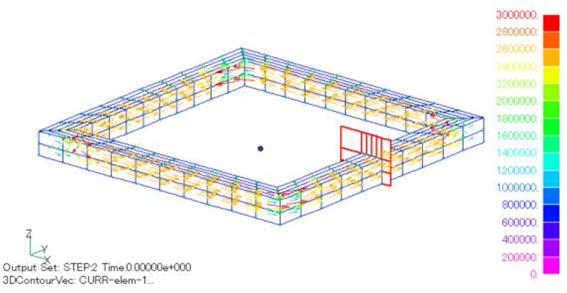Loop current defined by Potential Current Source (PHICOIL)
- TOP >
- Analysis Examples by Functions (List) >
- Loop current defined by Potential Current Source (PHICOIL)
Summary
EMSolution has a "potential current source (PHICOIL)" expressed by an electric scalar potential. With this feature, coil currents flowing in and out of the Bn=0 surface and currents flowing in and out of periodically symmetric surfaces can be defined. We are pleased to report that PHICOIL can now be used to define coils that loop in the computational domain.
Explanation
The representation of a looping coil by a surface inflow current source (SUFCUR) has already been described, but here it is represented by a gap element as well. As shown in Fig.1, the gap surface is defined in the form of a disconnection that is one or more layers out from the coil conductor. Current is defined in the direction of the gap surface (right-hand thread direction in nodal order). In Fig.1, the symmetry condition for the Ht=0 plane is used, but it is not necessary to define beyond the symmetry plane.
The current density distribution defined by PHICOIL shows an inward current distribution where the coil bends, as shown in Fig. 1. In this model, the coil can also be defined by "internal current source (ELMCUR)" or "surface defined current source (SDEFCOIL)", but PHICOIL does not require a rectangular cross-section and is easier to define. SUFCUR can be used for AC steady-state calculations and transient analysis, but the current distribution is not fixed and corresponds to current flowing through a bulk conductor and cannot be used for static magnetic field analysis. PHICOIL has a fixed current distribution and can be used in DC analysis by giving the DC steady-state current distribution as a coil source. Fig. 2 shows the current distribution obtained by SUFCUR for the same model with a very long time period of 100 s. It is almost the same as in Fig. 1, and you can see that the current in PHICOIL corresponds to the DC steady-state current.
The rest of this page is for members only.
Analysis Examples by Functions
Current magnetic field source
- PHICOIL in rotational z-anti-mirroring symmetry
- Loop current defined by Potential Current Source (PHICOIL)
- PHICOIL at periodic boundaries
- SDEFCOIL and PHICOIL
- Steady-state DC+AC analysis of bulk conductors using PHICOIL and SUFCUR
- Heat generation output of current magnetic field sources
- DC current field analysis of bulk conductors
- Current Field Analysis on Periodic Boundaries
©2020 Science Solutions International Laboratory, Inc.
All Rights reserved.




